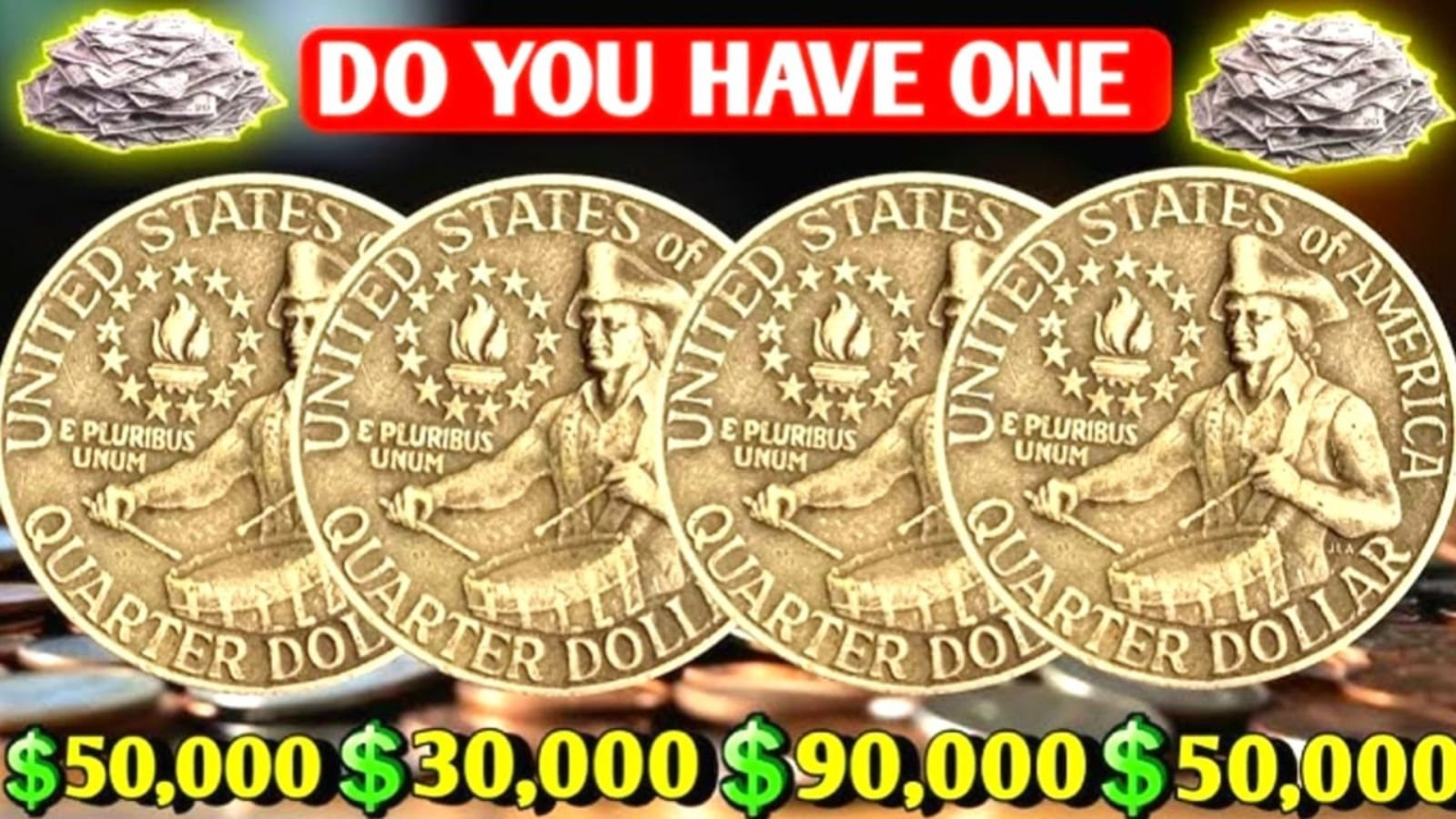For most of us, a quarter is nothing more than loose change we toss into a drawer, feed into a parking meter, or drop into a vending machine. But what if one of those ordinary-looking coins wasn’t so ordinary after all? Imagine holding a 25-cent piece that’s actually worth an astronomical $250 million. It sounds like a fantasy, but in the fascinating world of numismatics (coin collecting), it’s more real than you might think—thanks to the elusive and Rare Bicentennial Quarter.
That’s right—some extremely rare versions of the Rare Bicentennial Quarter, minted in 1976 to commemorate America’s 200th year of independence, are said to be worth hundreds of millions of dollars. While millions of these quarters were made for everyday use, a few rare variants were struck under very unusual circumstances. These ultra-rare versions are the stuff of legend, and they could still be hiding in coin jars, tucked in drawers, or even circulating in loose change today.
Let’s dig deep into what makes the Rare Bicentennial Quarter so valuable, what versions to look for, and how you might be able to spot one if luck is on your side.
What Exactly Is a Bicentennial Quarter?
To celebrate the United States’ 200th birthday, the U.S. Mint decided to temporarily redesign three of the most commonly used coins in 1976—the quarter, half dollar, and dollar coin. These special edition coins were minted with unique reverse designs and the dual date “1776–1976” instead of the usual single-year marking.
The quarter was given a special reverse design featuring a colonial-era drummer boy and a torch encircled by 13 stars, representing the original colonies. This fresh look was meant to honor America’s fight for independence and the spirit of patriotism. Millions of these quarters entered circulation and, for most, they were a fun collectible or simply change for laundry day.
But among the vast numbers produced, a few unique versions of the Rare Bicentennial Quarter were created—intentionally or by mistake—that have turned into highly sought-after collector’s items. Some of these coins now carry jaw-dropping price tags that seem almost surreal.
Why Are Some Bicentennial Quarters Worth $250 Million?
So how does a humble 25-cent coin soar to a value of $250 million? It comes down to several key factors that make certain specimens of the Rare Bicentennial Quarter so special.
- Prototype or Pattern Coins: These are coins produced before official minting begins, used to test designs and strike quality. Some of these prototypes were never meant to be released to the public, making them exceptionally rare.
- Mint Errors: In rare cases, errors like double strikes, off-center printing, missing elements, or planchet mistakes occurred. These flawed coins are rare because most are caught and destroyed before leaving the Mint.
- Unique Metal Composition: Most Bicentennial Quarters were made from a copper-nickel blend. However, some were struck in 40% silver for collector sets. Even rarer are the quarters mistakenly minted on silver planchets or other experimental metals.
- Perfect Grade: Coins rated MS70 (Mint State 70) by grading companies like PCGS or NGC are considered flawless. A Rare Bicentennial Quarter in MS70 condition becomes exponentially more valuable.
- Historical & Cultural Value: Beyond rarity, the coin’s place in U.S. history adds emotional and cultural significance, enhancing its market value among collectors and historians alike.
The 10 Most Valuable Rare Bicentennial Quarters
Collectors and experts have speculated on the existence of a few ultra-rare Bicentennial Quarters, each with a unique twist that makes them worth a fortune. Below are ten examples said to be valued at up to $250 million each under the right conditions:
- 1976-S Silver Proof Error Bicentennial Quarter – Struck on a silver planchet with a minting mistake.
- 1976 Double Die Obverse Bicentennial Quarter – Shows doubling on the front-side text or imagery.
- 1976 No Mint Mark Quarter Graded MS70 – Perfect quality, with no identifying mint mark, extremely rare.
- 1976 Off-Center Strike Bicentennial Quarter – Part of the design is missing due to a misaligned strike.
- 1976-S Type II Silver Proof – Ultra Cameo Finish – Rare mirror-like finish with deep contrast.
- 1976 Quarter on Wrong Planchet – Minted on a foreign or incorrect metal disc.
- 1976 Inverted S Mint Mark Quarter – Rare mint mark misplacement or reversal.
- 1976-S Clad Proof Quarter with Full Band Detail – Extremely crisp details, struck with high precision.
- 1976 Triple Die Reverse Bicentennial Quarter – Rare error where reverse features appear three times over.
- 1976-S Special Presentation Strike – A coin struck for dignitaries or officials in special conditions.
Each of these coins exhibits multiple layers of rarity, which is why their speculative value has climbed into nine figures.
Rare Bicentennial Quarter Facts at a Glance
| Feature | Details |
|---|---|
| Coin Name | Rare Bicentennial Quarter |
| Year Minted | 1976 |
| Mint Marks | None, D (Denver), S (San Francisco) |
| Unique Reverse | Drummer Boy with Torch & 13 Stars |
| Date Shown on Coin | 1776–1976 |
| Rare Materials | 40% Silver, Error Metals |
| Estimated Value (Rare Type) | $250 Million |
| Grading Worth Considering | MS68 to MS70 (PCGS or NGC) |
| Circulation Status | A few may still be in public circulation |
Could One of These Be Sitting in Your Coin Jar?
The most astonishing part of this story is that some of these Rare Bicentennial Quarters may not be locked away in collector vaults or museum displays. There’s a genuine possibility that one is still circulating. Over the decades, coins move between hands, cash registers, coin rolls, and collections. Many people overlook rare variants simply because they don’t know what to look for.
So, how can you increase your chances of spotting one?
- Start by examining the date: Look for “1776–1976” on the obverse side.
- Flip the coin over: Confirm that the reverse side features the drummer boy design.
- Check for mint marks: These appear just below the date on the obverse side.
- Inspect carefully for any abnormalities: Double images, off-center strikes, or unusual colors are signs of rare variants.
- Weigh your coin: A silver Bicentennial Quarter should weigh around 5.75 grams, compared to 5.67 grams for standard clad versions.
- Use a magnet: Regular quarters are not magnetic; any attraction could mean an odd composition.
Frequently Asked Questions About the Rare Bicentennial Quarter
Q1: Are any Bicentennial Quarters really worth $250 million?
A1: While the typical Bicentennial Quarter is only worth 25 cents, some ultra-rare examples with specific errors or prototypes are believed to be worth as much as $250 million by collectors and enthusiasts, though few have ever sold publicly for that amount.
Q2: How can I tell if I have a valuable Bicentennial Quarter?
A2: Examine the mint mark, metal content, strike quality, and any errors. If the coin appears unusual or pristine, consult a professional coin grader.
Q3: Where can I get a Rare Bicentennial Quarter appraised?
A3: Reputable coin grading services such as PCGS (Professional Coin Grading Service) or NGC (Numismatic Guaranty Company) can evaluate your coin and issue a certified grade.
Q4: Can I sell my rare quarter online?
A4: Absolutely. Sites like eBay, Heritage Auctions, and GreatCollections offer platforms where you can list or auction rare coins to serious collectors.
Q5: Is coin collecting a good investment?
A5: When done with proper knowledge and care, coin collecting can be both a rewarding hobby and a profitable long-term investment. Rare coins tend to hold or increase in value over time, especially those with historical or minting anomalies.
Final Thoughts: Check Your Change—You Might Be Sitting on a Goldmine
The idea that something as humble and ordinary as a quarter could be worth $250 million is as thrilling as it is real. The Rare Bicentennial Quarter is a testament to how much hidden value lies in overlooked places. Whether you’re a dedicated numismatist or just someone cleaning out an old coin jar, it’s worth taking a second look at those 1976 quarters.
Who knows? That coin jingling in your pocket or resting at the bottom of your junk drawer might just be your ticket to unimaginable wealth. The next time you handle a quarter, pause for a moment—it could be far more than 25 cents.
Would you like a printable checklist or visual guide to help identify rare Bicentennial Quarters?
Some Important Link
| Telegram Group | Click Here |
| WhatsApp Group | Click Here |
| Home Page | Click Here |















